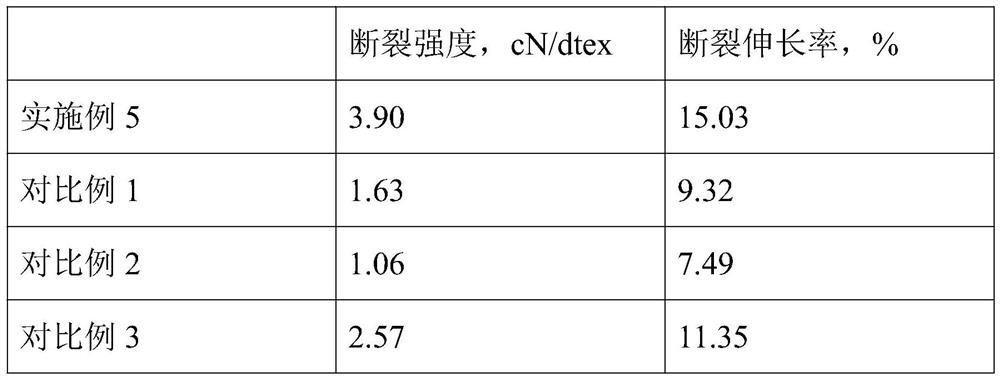Nano-antibacterial composite fibers for non-woven fabric processing and preparation method thereof
A technology of composite fibers and non-woven fabrics, applied in the fields of fiber chemical characteristics, rayon manufacturing, textiles and papermaking, etc., can solve the problem of reducing the breaking strength of chitosan fibers, low mechanical strength of chitosan fibers, and antibacterial effect of fiber fabrics Decay and other problems, to achieve the effect of reducing detachment and dissolution, enhancing antibacterial effect and antibacterial life, enhancing dimensional stability and mechanical properties
- Summary
- Abstract
- Description
- Claims
- Application Information
AI Technical Summary
Problems solved by technology
Method used
Image
Examples
Embodiment 1
[0027] A preparation method of nano antibacterial composite fiber for non-woven fabric processing, comprising the steps of:
[0028] S1. Add 2kg of nano-titanium dioxide into 40kg of water, ultrasonically disperse for 5 minutes, use concentrated sulfuric acid to adjust the pH of the system to 2.5-4, add 3kg of maleic anhydride, stir at 60°C for 5 hours under nitrogen protection, filter with suction, and wash with methanol once. Dried in an oven at 50°C, pulverized to obtain grafted nano-powder;
[0029] S2. Add 5kg of chitosan to 70kg of acetic acid solution with a concentration of 0.5mol / L and stir evenly. Under nitrogen protection, add 4kg of acrylic acid and 3kg of grafted nano-powder and stir evenly. Add 1kg of hydrogen peroxide and react at 40°C. 10h, obtain blending solution;
[0030] S3. Extrude the blended solution from a spinneret hole with an aperture of 0.75 mm at a rate of 8 mm / min through a frequency conversion stepper, and enter it into an oxalic acid solution w...
Embodiment 2
[0032] A preparation method of nano antibacterial composite fiber for non-woven fabric processing, comprising the steps of:
[0033] S1. Add 6kg of nano-titanium dioxide into 20kg of water, ultrasonically disperse for 10min, use concentrated sulfuric acid to adjust the pH of the system to 2.5-4, add 1kg of maleic anhydride, under nitrogen protection, stir at 80°C for 2h, filter with suction, wash with methanol 4 times, Dried in an oven at 40°C and pulverized to obtain grafted nanopowder;
[0034] S2. Add 15kg of chitosan to 50kg of acetic acid solution with a concentration of 1.2mol / L and stir evenly. Under nitrogen protection, add 1kg of acrylic acid and 6kg of grafted nano-powder and stir evenly. Add 0.1kg of ammonium persulfate and heat at 60°C. React for 5h to obtain a blended solution;
[0035] S3. Extrude the blended solution from a spinneret hole with an aperture of 0.65 mm at a rate of 10 mm / min through a frequency-variable stepper, and enter it into an oxalic acid so...
Embodiment 3
[0037] A preparation method of nano antibacterial composite fiber for non-woven fabric processing, comprising the steps of:
[0038] S1. Add 3kg of nano-titanium dioxide into 35kg of water, ultrasonically disperse for 6 minutes, use concentrated sulfuric acid to adjust the pH of the system to 2.5-4, add 2.5kg of maleic anhydride, stir at 65°C for 4 hours under nitrogen protection, filter with suction, and wash with methanol twice , dried in an oven at 47°C, and pulverized to obtain grafted nano-powder;
[0039] S2. Add 8kg of chitosan to 65kg of acetic acid solution with a concentration of 0.8mol / L and stir evenly. Under nitrogen protection, add 3kg of acrylic acid and 4kg of grafted nano-powder and stir evenly. Add 0.8kg of potassium persulfate and heat at 45°C. Reaction 8h, obtain blending solution;
[0040] S3, the blended solution is extruded from the spinneret hole with an aperture of 0.7mm at a rate of 8.5mm / min by a frequency conversion stepper, and solidified into an ...
PUM
 Login to View More
Login to View More Abstract
Description
Claims
Application Information
 Login to View More
Login to View More - R&D
- Intellectual Property
- Life Sciences
- Materials
- Tech Scout
- Unparalleled Data Quality
- Higher Quality Content
- 60% Fewer Hallucinations
Browse by: Latest US Patents, China's latest patents, Technical Efficacy Thesaurus, Application Domain, Technology Topic, Popular Technical Reports.
© 2025 PatSnap. All rights reserved.Legal|Privacy policy|Modern Slavery Act Transparency Statement|Sitemap|About US| Contact US: help@patsnap.com


